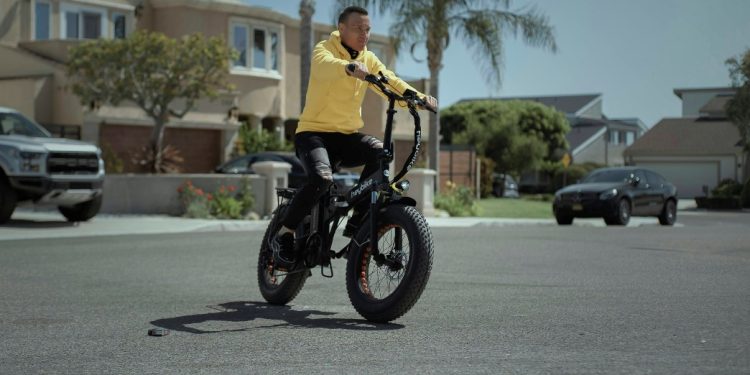Winter cycling in Canada can be an exhilarating experience, offering a unique way to explore the country’s breathtaking landscapes even when snow blankets the ground.
With the right equipment, such as an eBike by HeyBike, you can confidently navigate snowy and icy trails, turning a winter ride into an enjoyable adventure.
However, riding through these conditions requires preparation, proper gear, and a good understanding of the trails.
In this guide, we will explore how to navigate snowy trails on an eBike, focusing on the essentials that make winter cycling in Canada both safe and enjoyable.
Preparing Your eBike for Winter Cycling
Winter cycling in Canada can be a thrilling experience, especially when you’re equipped with a dependable eBike by HeyBike. Known for their durability and performance, these eBikes handle snowy conditions exceptionally well.
Still, proper preparation will help you get the most out of your ride, ensuring a safe and enjoyable winter cycling adventure.
- Battery Care: The battery is the heart of your eBike, and cold temperatures can reduce its efficiency. In Canada, where winter temperatures can dip well below freezing, it’s essential to keep your battery warm. Consider storing the battery indoors when not in use and avoid exposing it to the cold for extended periods. Some riders even use insulated covers to protect the battery while riding.
- Tire Choice: Tires play a significant role in winter cycling. For snowy trails, fat tires with deeper treads provide better traction and stability. These tires are specifically designed to handle soft surfaces like snow, giving you more control over your electric bike in Canada‘s winter terrain. Additionally, some cyclists opt for studded tires, which offer extra grip on icy patches.
- Lubrication: Winter conditions can cause your bike’s components to seize up due to moisture and freezing temperatures. Use a wet or winter-specific lubricant on the chain and other moving parts to keep them running smoothly. Regular maintenance checks are also advisable to identify any wear and tear caused by the harsh weather.
- Lighting: Shorter daylight hours mean that visibility can be a challenge during winter rides. Equip your eBike with powerful front and rear lights to make sure you can see and be seen on the trails. Reflective gear is also a good addition to enhance your visibility to others. With your eBike prepared for winter, you’re ready to explore Canada’s snowy landscapes. But what should you consider when selecting a trail?
Choosing the Right Trails for Winter eBiking
Canada is home to an extensive network of trails, many of which are accessible year-round. However, not all trails are suitable for winter cycling. Here are some factors to consider when choosing the right trail for your winter eBike adventure.
Trail Conditions: Before setting out, check the current trail conditions. Some trails are groomed for winter activities, making them ideal for eBiking. Groomed trails are often packed and maintained, providing a more stable surface to ride on.
For example, the Gatineau Park in Quebec and Alberta’s Banff National Park offer well-maintained trails that are popular among winter cyclists.
Elevation and Terrain: Consider the elevation and terrain of the trail. High-elevation trails can be more challenging due to deeper snow and steeper inclines. Beginners may want to start with flatter, less demanding trails before tackling more difficult routes.
The Confederation Trail in Prince Edward Island, for example, offers a relatively flat and scenic route that is accessible during winter.
Accessibility and Safety: Choose trails that are easily accessible and offer amenities like parking, rest areas, and emergency services. It’s also wise to select trails that are popular with other winter sports enthusiasts, as these areas are more likely to be monitored and maintained.
Local Regulations: Some trails have specific regulations regarding eBikes, especially in winter. Check local guidelines to make sure that eBikes are allowed on the trails you plan to visit. In some cases, certain trails may be reserved for cross-country skiing or snowshoeing, so it’s essential to respect these rules to avoid conflicts.
With the right trail selected, let’s discuss how to dress appropriately for winter cycling.
Dressing for Success: Winter Cycling Gear
Staying warm and dry is crucial for a comfortable winter cycling experience. The right clothing and gear can make all the difference in enjoying your ride, even in the coldest conditions.
Layering: Dressing in layers is the key to regulating your body temperature during winter rides. A moisture-wicking base layer followed by an insulating layer would be ideal.
Finally, add a windproof and waterproof outer layer to protect against the elements. Remember, it’s easier to remove layers if you get too warm than to add them once you’re cold.
Gloves and Footwear: Extremities like your hands and feet are particularly vulnerable to the cold. Invest in insulated, waterproof gloves that allow for agility while keeping your hands warm.
For your feet, winter cycling boots or overshoes can provide the necessary warmth and protection. Wool socks are also an excellent option for keeping your feet dry and warm.
Head and Face Protection: A significant amount of heat is lost through the head, so wearing a thermal beanie or balaclava under your helmet is advisable. If the wind chill is particularly harsh, a face mask can help protect your skin from frostbite.
Eyewear: Snow and ice can reflect sunlight, leading to glare that makes it difficult to see. Wearing sunglasses or goggles with UV protection can help reduce glare and protect your eyes from wind and debris.
Proper clothing is essential, but so is knowing how to handle your eBike on snowy and icy terrain.
Riding Techniques for Snowy Trails
Winter cycling presents unique challenges that require a different set of riding techniques compared to other seasons. Understanding these techniques will help you navigate snowy trails more confidently.
Start Slow: Snowy trails can be unpredictable, with varying levels of grip and stability. Start your ride at a slower pace to get a feel for the conditions. Gradually increase your speed as you become more comfortable with the terrain.
Balance and Posture: Maintaining a balanced and upright posture is crucial when riding on snow. Keep your weight centered over the bike, with a slight lean forward to help with traction. Avoid sudden movements, as they can cause your bike to slip.
Brake Control: Use your brakes cautiously to avoid skidding. Apply the brakes gradually and evenly, and rely more on your rear brake to prevent the front wheel from locking up. In icy conditions, it’s best to reduce your speed early rather than braking suddenly.
Cornering: Cornering on snow requires extra caution. Approach turns at a slower speed and avoid leaning too far into the turn. Instead, steer with your handlebars while keeping your body upright.
Pedal Smoothly: Pedal in a smooth, consistent motion to maintain traction. Jerky or sudden pedaling can cause your rear wheel to lose grip. If you find yourself on an icy patch, ease off the pedals and coast until you’re back on more stable ground.
By mastering these techniques, you’ll be better equipped to tackle snowy trails and enjoy the winter wonderland that Canada offers.
Winter cycling in Canada offers a unique way to explore the country’s stunning landscapes while staying active during the colder months. With the right preparation, gear, and techniques, you can navigate snowy trails safely and enjoyably.
Whether you’re riding through the groomed paths of Quebec’s Gatineau Park or exploring the flat, scenic routes of Prince Edward Island’s Confederation Trail, ebikes by HeyBike make exploring a wonderful experience.


















